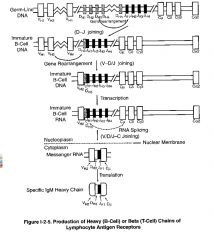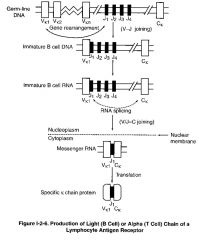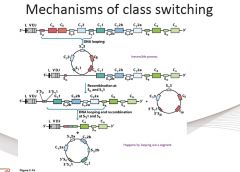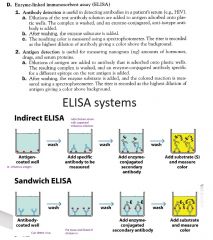![]()
![]()
![]()
Use LEFT and RIGHT arrow keys to navigate between flashcards;
Use UP and DOWN arrow keys to flip the card;
H to show hint;
A reads text to speech;
13 Cards in this Set
- Front
- Back
|
What is the structure of antibodies?
|

-composed of 2 heavy chains and 2 light chains, connected by disulphide bridges
-one heavy & one light chain combine to form an antigen binding site at the N-terminus of both chains -each antibody has 2 antigen binding sites which allow the antibody to cross link two-antigens together LIGHT CHAIN: has a variable domain, binds antigen, and a constant domain which does not (there are 2 constant domains in genome, kappa or lambda) HEAVY CHAIN: 1 variable domain, binds antigen, and 3 constant domains, do not bind antigen -the different constant parts o the Ab give rise to different isotypes -the major isotypes are IgG, IgA, IgM, IgE & IgD |
|
|
What is the clonal selection theory?
|
Each B cell has a specific antibody as a cell surface receptor. The arrangement and generation of antibody genes occurs prior to any exposure to antigen. When a soluble antigen is present, it binds to the antibody on the surface of B cells that have the correct specificity. These B cell clones develop into antibody-producing plasma cells or memory cells. Only B cells, which are antigen-specific, are capable of secreting antibodies.
|
|
|
How is antibody diversity generated?
|
-through somatic gene rearrangement
|
|
|
Describe the generation of the antibody heavy chain.
|

HEAVY CHAIN
-3 gene segments (V, D, and J) are combined to create the variable domain of the B cell heavy chain or TCR β chain -VDJ rearrangements in DNA produce the diversity of heavy chain variable domains -first 1 D segment is attached to a J segment through removing the intervening sequence -next the DJ sequence is attached to one of the VH segments, this is irreversible ie the missing piece of DNA can never be recovered - μ or δ constant domains are added to complete the heavy chain by splicing the RNA (ie. removing the intron) → this is transcribed into mRNA |
|
|
Describe the generation of the antibody light chain.
|

LIGHT CHAIN
-VJ rearrangements in DNA produce the diversity of light chain variable domains -first one J segment is attached to a V segment through removing intervening sequences of DNA -κ or λ constant domains are added to complete the light chain by splicing the RNA (ie. removing the intron) |
|
|
What happens if an animal is deficient in the enzymes responsible for VDJ rearrangements?
|
-these enzymes are DNA dependent protein kinases, RAG-1 & RAG-2
-it results in severe combined immunodeficiency (SCID) whereby no B cells (or T cells) are produced -seen in Arabian foals, homozygous deficiency -can’t recombine B & T cell receptors = no adaptive immunity, can only survive in germ free conditions |
|
|
There are 2 possible heavy chains & 4 possible light chains (1 κ from mom, 1 κ from dad, 1 λ from mom, 1 λ from dad), yet B cells have antibodies with one specificity, what makes this possible?
|
-once a functional product has been made, the homologous chromosome is inactivated (allelic exclusion)
|
|
|
Describe the development of B cells? What is class switching?
|

-originate from haematopoietic progenitor cells in bone marrow
-B cells become Pro-B cells upon rearrangement of heavy chain ↓ -the rearranged heavy chain is expressed in association with a surrogate light chain on the surface of the B cell, which is now called a Pre-B cell -this occurs in the bone marrow and it is at this level that allelic exclusion occurs ↓ -light chain gets rearranged to produce an immature B-cell ↓ -these cells can now undergo differential mRNA splicing to produce both IgM & IgD -these cells are now called mature B cells and migrate into peripheral lymphoid organs ↓ -upon encountering of antigen that binds to the surface Ig the B cell gets activated -leads to differentiation into IgM producing plasma cells = massive increase in B cells or clonal expansion -some B cells become memory B cells of various isotypes while others go on to produce and secrete antibodies of various isotyopes -the process of changing from one isotype to another is called class switching |
|
|
What is primary immune response? What is secondary immune response and why is it more efficient?
|
Primary immune response – first time the immune system encounters antigen
Secondary immune response – immune system encounters antigen for a second time -B cells produce a faster immune response, antibodies with higher affinity & better functionality |
|
|
Why is class switching important and what causes class switching?
|
-important in the humoral immune response because it allows the immune system to assign different functions to the antibodies by expressing them with a different heavy chain
-some antibodies will be more appropriate in dealing with certain pathogens compared to others -the decision as to which isotype is produced is regulated by cytokines and T cells influence the outcome of which isotype is produced |
|
|
How does class switching occur?
|

-occurs through a DNA looping mechanism followed by a recombination event
-following this recombination event, a circular DNA fragment is excised from the genome -another recombination event can happen later, BUT it is impossible to recover what has been previously excised -thus class switching is a one way event that cannot be reverted -as a result, once a certain isotype is produced by a B cell it is not possible to go back upstream isotypes but it is possible to continue to switch to an isotype downstream in the DNA sequence |
|
|
What are polyclonal & monoclonal antibodies?
|
Polyclonal – collecting serum from an animal that has been immunized against an antigen will result in a large number of different antibodies against the antigen that will not only recognize different epitopes but will be different isotypes
Monoclonal – purifying the antibodies of one B cell in order to have control of specificity and isotype of the antibody |
|
|
What are some examples of veterinary applications of monoclonal antibodies?
|

|

